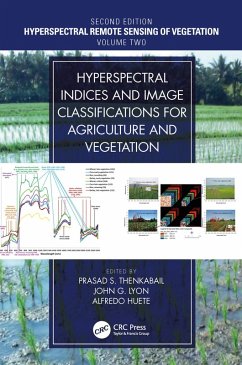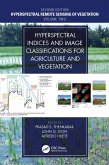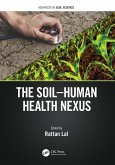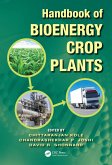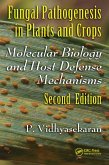Hyperspectral Indices and Image Classifications for Agriculture and Vegetation (eBook, PDF)
Redaktion: Thenkabail, Prasad S.; Huete, Alfredo; Lyon, John G.
44,95 €
44,95 €
inkl. MwSt.
Sofort per Download lieferbar

22 °P sammeln
44,95 €
Als Download kaufen

44,95 €
inkl. MwSt.
Sofort per Download lieferbar

22 °P sammeln
Jetzt verschenken
Alle Infos zum eBook verschenken
44,95 €
inkl. MwSt.
Sofort per Download lieferbar
Alle Infos zum eBook verschenken

22 °P sammeln
Hyperspectral Indices and Image Classifications for Agriculture and Vegetation (eBook, PDF)
Redaktion: Thenkabail, Prasad S.; Huete, Alfredo; Lyon, John G.
- Format: PDF
- Merkliste
- Auf die Merkliste
- Bewerten Bewerten
- Teilen
- Produkt teilen
- Produkterinnerung
- Produkterinnerung

Bitte loggen Sie sich zunächst in Ihr Kundenkonto ein oder registrieren Sie sich bei
bücher.de, um das eBook-Abo tolino select nutzen zu können.
Hier können Sie sich einloggen
Hier können Sie sich einloggen
Sie sind bereits eingeloggt. Klicken Sie auf 2. tolino select Abo, um fortzufahren.

Bitte loggen Sie sich zunächst in Ihr Kundenkonto ein oder registrieren Sie sich bei bücher.de, um das eBook-Abo tolino select nutzen zu können.
Evaluating the performance of various types of hyperspectral vegetation indices in characterizing agricultural crops, this volume discusses non-invasive quantification of foliar pigments, leaf nitrogen concentration of cereal crop, the estimation of nitrogen content in crops and pastures, forest leaf chlorophyll content, among other applications.
- Geräte: PC
- mit Kopierschutz
- eBook Hilfe
- Größe: 11.75MB
Andere Kunden interessierten sich auch für
![Hyperspectral Indices and Image Classifications for Agriculture and Vegetation (eBook, ePUB) Hyperspectral Indices and Image Classifications for Agriculture and Vegetation (eBook, ePUB)]() Hyperspectral Indices and Image Classifications for Agriculture and Vegetation (eBook, ePUB)44,95 €
Hyperspectral Indices and Image Classifications for Agriculture and Vegetation (eBook, ePUB)44,95 €![Soil and Groundwater Remediation Technologies (eBook, PDF) Soil and Groundwater Remediation Technologies (eBook, PDF)]() Soil and Groundwater Remediation Technologies (eBook, PDF)46,95 €
Soil and Groundwater Remediation Technologies (eBook, PDF)46,95 €![The Soil-Human Health-Nexus (eBook, PDF) The Soil-Human Health-Nexus (eBook, PDF)]() The Soil-Human Health-Nexus (eBook, PDF)78,95 €
The Soil-Human Health-Nexus (eBook, PDF)78,95 €![Sustainable Soil and Land Management and Climate Change (eBook, PDF) Sustainable Soil and Land Management and Climate Change (eBook, PDF)]() Sustainable Soil and Land Management and Climate Change (eBook, PDF)51,95 €
Sustainable Soil and Land Management and Climate Change (eBook, PDF)51,95 €![Handbook of Bioenergy Crop Plants (eBook, PDF) Handbook of Bioenergy Crop Plants (eBook, PDF)]() Handbook of Bioenergy Crop Plants (eBook, PDF)51,95 €
Handbook of Bioenergy Crop Plants (eBook, PDF)51,95 €![Soil Amendments for Sustainability (eBook, PDF) Soil Amendments for Sustainability (eBook, PDF)]() Soil Amendments for Sustainability (eBook, PDF)169,95 €
Soil Amendments for Sustainability (eBook, PDF)169,95 €![Fungal Pathogenesis in Plants and Crops (eBook, PDF) Fungal Pathogenesis in Plants and Crops (eBook, PDF)]() P. VidhyasekaranFungal Pathogenesis in Plants and Crops (eBook, PDF)185,95 €
P. VidhyasekaranFungal Pathogenesis in Plants and Crops (eBook, PDF)185,95 €-
-
-
Evaluating the performance of various types of hyperspectral vegetation indices in characterizing agricultural crops, this volume discusses non-invasive quantification of foliar pigments, leaf nitrogen concentration of cereal crop, the estimation of nitrogen content in crops and pastures, forest leaf chlorophyll content, among other applications.
Dieser Download kann aus rechtlichen Gründen nur mit Rechnungsadresse in A, B, BG, CY, CZ, D, DK, EW, E, FIN, F, GR, HR, H, IRL, I, LT, L, LR, M, NL, PL, P, R, S, SLO, SK ausgeliefert werden.
Produktdetails
- Produktdetails
- Verlag: Taylor & Francis
- Seitenzahl: 332
- Erscheinungstermin: 7. Dezember 2018
- Englisch
- ISBN-13: 9781351659253
- Artikelnr.: 54793064
- Verlag: Taylor & Francis
- Seitenzahl: 332
- Erscheinungstermin: 7. Dezember 2018
- Englisch
- ISBN-13: 9781351659253
- Artikelnr.: 54793064
Dr. Prasad S. Thenkabail, Research Geographer-15, U.S. Geological Survey (USGS), is a world-recognized expert in remote sensing science with multiple major contributions in the field sustained over more than 30 years. He obtained his PhD from the Ohio State University in 1992 and has over 140+ peer-reviewed scientific publications. Dr. Thenkabail has conducted pioneering cutting-edge research in the area of hyperspectral remote sensing of vegetation (https://www.usgs.gov/wgsc/GHISA/) and in that of global croplands and their water use for food security (www.croplands.org). Dr. Thenkabail's contributions to series of leading edited books on remote sensing science along with his research and other contributions in the subject places his as a noted global expert in remote sensing science. He edited three-volume book entitled Remote Sensing Handbook published by Taylor and Francis, with 82 chapters and more than 2000 pages, widely considered a "magnus opus" encyclopedic standard reference for students, scholars, practitioners, and major experts in remote sensing science. He has recently completed editing four-volume Hyperspectral Remote Sensing of Vegetation. He has also edited a book on Remote Sensing of Global Croplands for Food Security. He is currently an editor-in-chief of the Remote Sensing open access journal published by MDPI; an associate editor of the journal Photogrammetric Engineering and Remote Sensing (PERS) of the American Society of Photogrammetry and Remote Sensing (ASPRS); and an editorial advisory board member of the International Society of Photogrammetry and Remote Sensing (ISPRS) Journal of Photogrammetry and Remote Sensing. NASA and USGS selected him on the Landsat Science team (2007-2011). Earlier, he served on the editorial board of Remote Sensing of Environment for many years (2007-2017). He has won three best paper awards from ASPRS for his publications in PE&RS. Detailed bio of Dr. Thenkabail can be found here: https://www.usgs.gov/staff-profiles/prasad-thenkabail John G. Lyon has conducted scientific and engineering research and administrative functions throughout his career. He is formerly the senior physical scientist in the U.S. Environmental Protection Agency's Office of Research and Development (ORD) and Office of the Science Advisor in Washington, DC, where he co-led work on the Group on Earth Observations and the USGEO subcommittee of the Committee on Environment and Natural Resources, and research on geospatial issues. Lyon was director of ORD's Environmental Sciences Division for approximately eight years. He was educated at Reed College in Portland, Oregon, and the University of Michigan in Ann Arbor. Professor Alfredo Huete leads the Ecosystem Dynamics Health and Resilience research program within the Climate Change Cluster (C3) at the University of Technology Sydney, Australia. His main research interest is in using remote sensing to study and analyze broad scale vegetation health and functioning. Recently, he used remote sensing and field measurements to understand the phenology patterns of tropical rainforests and savannas in the Amazon and Southeast Asia and his Amazon work was featured in a National Geographic television special entitled "The Big Picture". Currently his research involves coupling eddy covariance tower flux measurements with ground spectral sensors and satellite observations to study carbon and water cycling across Australian landscapes. He is actively involved with several international space programs, including the NASA-EOS MODIS Science Team, the Japanese JAXA GCOM-SGLI Science Team, the European PROBA-V User Expert Group, and NPOESS-VIIRS advisory group.
Section I: Hyperspectral Vegetation Indices
1. Hyperspectral vegetation indices
[Dar A. Roberts, Keely L. Roth, Erin B. Wetherley, Susan K. Meerdink,
and Ryan L. Perroy]
2. Derivative hyperspectral vegetation indices in characterizing forest
biophysical and biochemical quantities
[Quan Wang, Jia Jin, Rei Sonobe, and Jing Ming Chen]
Section II: Hyperspectral Image Classification Methods and Approaches
3. Hyperpsectral image classification methods in vegetation and
agricultural
cropland studies
[Edoardo Pasolli, Saurabh Prasad, Melba M. Crawford, and James C.
Tilton]
4. Big Data Processing on Cloud Computing Architectures for
Hyperspectral Remote Sensing
[Zebin Wu, Jin Sun, and Yi Zhang]
Section III: Hyperspectral Vegetation Indices Applications to
Agriculture and Vegetation
5. Non-invasive Quantification of Foliar Pigments: Principles and
Implementation
[Anatoly Gitelson and Alexei Solovchenko]
6. Hyperspectral Remote Sensing of Leaf Nitrogen Concentration in Cereal
Crops
[Tao Cheng, Yan Zhu, Dong Li, Xia Yao, and Kai Zhou]
7. Optical remote sensing of vegetation water content
[Colombo Roberto, Busetto Lorenzo, Meroni Michele, Rossini Micol, and
Panigada Cinzia]
8. Estimation of nitrogen content in herbaceous plants using
hyperspectral vegetation indices
[D. Stroppiana, F. Fava, M. Boschetti, and P.A. Brivio]
9. Hyperspectral remote sensing of leaf chlorophyll content: from leaf,
canopy, to landscape scales
[Yongqin Zhang]
Section IV: Conclusions
10. Fifty-years of Advances in Hyperspectral Remote Sensing of
Agriculture and Vegetation: Summary, Insights, and Highlights of
Volume II: Hyperspectral Vegetation Indices and Image Classifications
for Agriculture and Vegetation
[Prasad S. Thenkabil, John G. Lyon, and Alfredo Huete]
1. Hyperspectral vegetation indices
[Dar A. Roberts, Keely L. Roth, Erin B. Wetherley, Susan K. Meerdink,
and Ryan L. Perroy]
2. Derivative hyperspectral vegetation indices in characterizing forest
biophysical and biochemical quantities
[Quan Wang, Jia Jin, Rei Sonobe, and Jing Ming Chen]
Section II: Hyperspectral Image Classification Methods and Approaches
3. Hyperpsectral image classification methods in vegetation and
agricultural
cropland studies
[Edoardo Pasolli, Saurabh Prasad, Melba M. Crawford, and James C.
Tilton]
4. Big Data Processing on Cloud Computing Architectures for
Hyperspectral Remote Sensing
[Zebin Wu, Jin Sun, and Yi Zhang]
Section III: Hyperspectral Vegetation Indices Applications to
Agriculture and Vegetation
5. Non-invasive Quantification of Foliar Pigments: Principles and
Implementation
[Anatoly Gitelson and Alexei Solovchenko]
6. Hyperspectral Remote Sensing of Leaf Nitrogen Concentration in Cereal
Crops
[Tao Cheng, Yan Zhu, Dong Li, Xia Yao, and Kai Zhou]
7. Optical remote sensing of vegetation water content
[Colombo Roberto, Busetto Lorenzo, Meroni Michele, Rossini Micol, and
Panigada Cinzia]
8. Estimation of nitrogen content in herbaceous plants using
hyperspectral vegetation indices
[D. Stroppiana, F. Fava, M. Boschetti, and P.A. Brivio]
9. Hyperspectral remote sensing of leaf chlorophyll content: from leaf,
canopy, to landscape scales
[Yongqin Zhang]
Section IV: Conclusions
10. Fifty-years of Advances in Hyperspectral Remote Sensing of
Agriculture and Vegetation: Summary, Insights, and Highlights of
Volume II: Hyperspectral Vegetation Indices and Image Classifications
for Agriculture and Vegetation
[Prasad S. Thenkabil, John G. Lyon, and Alfredo Huete]
Section I: Hyperspectral Vegetation Indices
1. Hyperspectral vegetation indices
[Dar A. Roberts, Keely L. Roth, Erin B. Wetherley, Susan K. Meerdink,
and Ryan L. Perroy]
2. Derivative hyperspectral vegetation indices in characterizing forest
biophysical and biochemical quantities
[Quan Wang, Jia Jin, Rei Sonobe, and Jing Ming Chen]
Section II: Hyperspectral Image Classification Methods and Approaches
3. Hyperpsectral image classification methods in vegetation and
agricultural
cropland studies
[Edoardo Pasolli, Saurabh Prasad, Melba M. Crawford, and James C.
Tilton]
4. Big Data Processing on Cloud Computing Architectures for
Hyperspectral Remote Sensing
[Zebin Wu, Jin Sun, and Yi Zhang]
Section III: Hyperspectral Vegetation Indices Applications to
Agriculture and Vegetation
5. Non-invasive Quantification of Foliar Pigments: Principles and
Implementation
[Anatoly Gitelson and Alexei Solovchenko]
6. Hyperspectral Remote Sensing of Leaf Nitrogen Concentration in Cereal
Crops
[Tao Cheng, Yan Zhu, Dong Li, Xia Yao, and Kai Zhou]
7. Optical remote sensing of vegetation water content
[Colombo Roberto, Busetto Lorenzo, Meroni Michele, Rossini Micol, and
Panigada Cinzia]
8. Estimation of nitrogen content in herbaceous plants using
hyperspectral vegetation indices
[D. Stroppiana, F. Fava, M. Boschetti, and P.A. Brivio]
9. Hyperspectral remote sensing of leaf chlorophyll content: from leaf,
canopy, to landscape scales
[Yongqin Zhang]
Section IV: Conclusions
10. Fifty-years of Advances in Hyperspectral Remote Sensing of
Agriculture and Vegetation: Summary, Insights, and Highlights of
Volume II: Hyperspectral Vegetation Indices and Image Classifications
for Agriculture and Vegetation
[Prasad S. Thenkabil, John G. Lyon, and Alfredo Huete]
1. Hyperspectral vegetation indices
[Dar A. Roberts, Keely L. Roth, Erin B. Wetherley, Susan K. Meerdink,
and Ryan L. Perroy]
2. Derivative hyperspectral vegetation indices in characterizing forest
biophysical and biochemical quantities
[Quan Wang, Jia Jin, Rei Sonobe, and Jing Ming Chen]
Section II: Hyperspectral Image Classification Methods and Approaches
3. Hyperpsectral image classification methods in vegetation and
agricultural
cropland studies
[Edoardo Pasolli, Saurabh Prasad, Melba M. Crawford, and James C.
Tilton]
4. Big Data Processing on Cloud Computing Architectures for
Hyperspectral Remote Sensing
[Zebin Wu, Jin Sun, and Yi Zhang]
Section III: Hyperspectral Vegetation Indices Applications to
Agriculture and Vegetation
5. Non-invasive Quantification of Foliar Pigments: Principles and
Implementation
[Anatoly Gitelson and Alexei Solovchenko]
6. Hyperspectral Remote Sensing of Leaf Nitrogen Concentration in Cereal
Crops
[Tao Cheng, Yan Zhu, Dong Li, Xia Yao, and Kai Zhou]
7. Optical remote sensing of vegetation water content
[Colombo Roberto, Busetto Lorenzo, Meroni Michele, Rossini Micol, and
Panigada Cinzia]
8. Estimation of nitrogen content in herbaceous plants using
hyperspectral vegetation indices
[D. Stroppiana, F. Fava, M. Boschetti, and P.A. Brivio]
9. Hyperspectral remote sensing of leaf chlorophyll content: from leaf,
canopy, to landscape scales
[Yongqin Zhang]
Section IV: Conclusions
10. Fifty-years of Advances in Hyperspectral Remote Sensing of
Agriculture and Vegetation: Summary, Insights, and Highlights of
Volume II: Hyperspectral Vegetation Indices and Image Classifications
for Agriculture and Vegetation
[Prasad S. Thenkabil, John G. Lyon, and Alfredo Huete]
